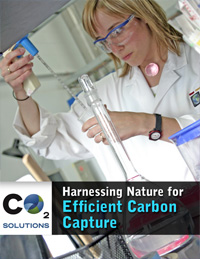By Cheryl Long
A pilot project between CO2 Solutions Inc. and Husky Energy is poised to change the way carbon dioxide (CO2) emissions impact the world’s climate, while offering a cost-efficient solution to companies that utilize the gas in their industrial applications.
The burning of carbon-based fuels accounts for approximately 70 percent of energy demands worldwide, and that number is expected to double by 2035. While the growth is indicative of a prospering economy, it also means that greenhouse gas emissions are likely to increase and result in disruptive climate change.
CO2 Solutions, headquartered in Quebec City, is the leader in the field of enzyme-enabled carbon capture technology and the project at Husky Energy’s Pikes Peak South heavy oil site in Saskatchewan will demonstrate the technology by capturing up to 10 tonnes of CO2 each day. The project will allow CO2 Solutions to validate the process, according to CEO Evan Price. “We have support for the pilot program from the CCEMC (Climate Change and Emissions Management Corporation) and from Natural Resources Canada, their ecoENERGY program. We’ve received support from the oil industry as well.”
That support is coming from members of the CO2 Capture Project (CCP), namely BP, Chevron, Eni, Petrobras, Shell and Suncor. The CCP is a partnership of several major energy companies working together to advance technologies that will support the deployment of industrial-scale CO2 capture and storage.
Construction to begin in early 2015
CO2 Solutions has been working with Montreal-based engineering firm Seneca to complete the design review and detailed engineering phase of the project. They’re now moving on to procurement and construction is expected to get underway early in 2015. The benefits will go beyond the capture of CO2, highlighting the technology’s varied commercial applications such as enhanced oil recovery, and the potential to be successful across a range of industries and geographic regions.
The Saskatchewan project will also signal the one of the last steps in CO2 Solutions’ efforts to commercialize their leading-edge technology. “Our shareholders have been very patient in allowing us to reach this point. This is the next step,” Price explained.
“We not only want to show very interesting returns for our shareholders but we also want to show governments around the world that applying CO2 capture technology to mitigate CO2 is something that can be done at a relatively low cost, and in doing so we’re going to be encouraging (government) regulations to fall into place.”
CO2 Solutions began developing its enzyme-based carbon capture technology in 1997, initially working on the removal of CO2 from ambient air. In 2006, the company shifted its focus to carbon capture from power plants but discovered that the process needed a more stable enzyme. (Enzymes accelerate the capture of carbon dioxide in an aqueous media, allowing for the efficient production of pure CO2 and also transforming it into usable forms of bicarbonate.) They joined forces with Codexis, a manufacturer of “highly optimized enzymes” for industrial processes, and developed a stable carbonic anhydrase (CA) enzyme for developmental use. The enzyme underwent rigorous testing during the process, including exposure to coal flue gases at the U.S. National Carbon Capture Center in Alabama. More recently, in a separate effort CO2 Solutions has developed its own proprietary enzymes, which it believes have similar or even greater potential and will remove the reliance on third-party enzyme suppliers.
Over $5 million in funding awarded
In 2012 and 2013, CO2 Solutions received $5.2 million in grant funding from the federal ecoENERGY Innovation Initiative and CCEMC towards a project to optimize and pilot the technology for CO2 capture from oil sands production. The resulting findings showed a process energy cost reduction of at least one-third compared to conventional technology, and that spurred the launch of the more extensive Husky pilot project that is underway today. “It was a very important milestone for us to receive this funding from CCEMC and Natural Resources Canada,” Price said.
The company is making huge strides in CO2 capture. Opportunities are opening up in several industries outside of oil and gas, including beverage carbonation, pulp and paper production, water filtration, greenhouse applications and chemical production. As of June 30, 2014, they had 46 issued and 37 pending patents broadly covering the use of the CA enzymes for carbon capture. “I’m proud of the whole portfolio in the sense that it gives us a very dominant position in this space; that we are really, truly the pioneers in carbon capture technology,” Price said.
Though the initial intent of CO2 Solutions was aimed at regulated markets where they hoped to influence changes in government regulations surrounding CO2 emissions and the effect on climate, it became clear that widespread, impactful laws would be slow in coming. “One of the few programs with any teeth is happening in Alberta where in 2007 the province promulgated the Specified Gas Emitters Regulation. This carbon tax requires a $15/tonne contribution be made to the CCEMC on some emissions,” Price explained. That money is going back into projects designed to further reduce emissions.
CO2 Solutions decided to focus its efforts in the unregulated markets, where CO2 was being sought as a low-cost industrial gas, knowing that in these markets there was still potential for benefits to the environment. “There are companies worldwide that are either using CO2 in their processes today, or are interested in obtaining more of the gas if it could be purchased at a low cost,” Price explained.
Huge demand for low-cost carbon dioxide
“Some of these consumers of CO2 are also emitters of CO2, so we see ourselves as closing the loop for them,” Price said. “For example, we came across a large soft drink bottler and it turns out that the amount of CO2 they need in their carbonated soda products is exactly the amount they emit though the boiler they deploy to heat water to sterilize their bottling production line..” The technology would allow CO2 Solutions to capture the bottler’s emitted carbon dioxide, put it through a scrubbing and filtration process, and then provide it back to the bottler for use in their soft drink production – a perfect example of “closing the loop”.
As the company moves forward in commercializing their technology, it’s no surprise that they have several pilot projects in the wings that have already acquired funding and are getting ready to launch. The Husky project is expected to be completed by late 2015 and they have another venture in North Dakota beginning this December with the University of North Dakota Energy & Environmental Research Center (EERC). That program will test the capture technology at the university’s facility using natural gas and coal flue gas, determining how CA performs in some of the most advanced systems under development for power and steam generation plants. The experiences and results from that testing are also expected to provide valuable input to the larger project with Husky.
With the potential for carbon dioxide use in so many applications, CO2 Solutions is in no rush to expand their research to other gases. “The CO2 pie is massive enough for us to dedicate all our resources on that,” Price said. “We see ourselves in collaboration with other companies that do have to clean other flue gases – sulphur, nitrogen, mercury – those flue gases have to be cleaned before we come in so we see ourselves working with them.”
In the meantime, the environmental impact of greenhouse gases is still very much on the minds of the CO2 Solutions team. They would like to see more stringent regulations put into place, and one of the best ways to accomplish that is by bringing in low-cost technology that works well, won’t hurt economic performance and has a substantial effect on CO2 mitigation.
“We’re not pushing regulation for regulation, but we think that if we’re going to make any headway on (CO2 mitigation) from a climate change perspective, there has to be a regulatory component,” Price said. “We’re not going to do it by ourselves.”
To learn more about CO2 Solutions and their ground-breaking work, visit www.co2solutions.com.







